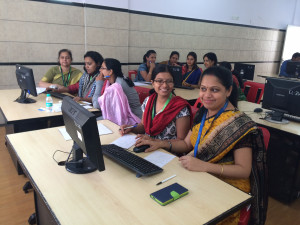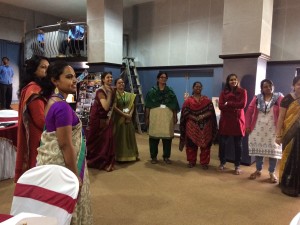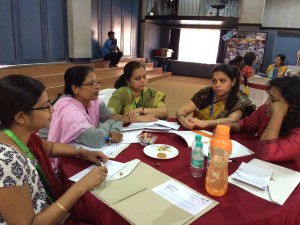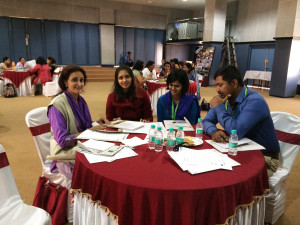40! She said, when I asked Madhushree how many participants had signed up for the workshop.
This was just before I was boarding the flight to Bangalore.
Now, for somebody who is neither a historian, nor a history teacher, the prospect of conducting a Teaching Divided Histories workshop for 40 history teachers can be rather overwhelming. So the next morning I headed towards Vidyashilp Academy from my hotel with great trepidation. Registrations over, the participants settled down around the various round tables set up in the spacious, well-equipped auditorium.
I began the workshop by referring to Fabian Schoneich’s introduction to Bangladeshi artist Naeem Mohaiemen’s work Prisoners of Shothik Itihash [Correct History]. History is generally defined by events that have a cause that lead up to a spiral of effects. Official history is generally written as a chronological narration of events that evidently seem of historical relevance. Nations, figures, wars, alliances—these build up the historical narration. Then there are minor histories—histories of a people, of individuals, families, communities—minor histories that are perceived as irrelevant and as a result marginalized and erased from official accounts.
Are these minor histories important? Do they have a role in peace building?
The discussion and debate that followed these two questions miraculously wiped away all my trepidations and set the tone for an in depth, engaged interaction for the rest of the day.
Soon it was time for the coffee break, post that I moved into the formal introduction of the Teaching Divided Histories project.
Originated by Nerve Centre, Northern Ireland the Teaching Divided Histories project aims to:
- Assist teachers and educators to overcome their fears and concerns around dealing with the past and challenge them to be more creative in their approach to the teaching of history in a digital age.
- Build cross-border synergies and international partnerships between post-conflict countries and enable sharing of experiences and best practice between educators, policy makers and curriculum planners.
- Provide teachers with the knowledge, confidence and creative skills to enable them to explore contentious history and identity in the classroom.
- Embed new and dynamic models of teaching and learning about conflict in subjects such as History, English and ICT.
- Create a bank of online learning resources and teacher guidance that will be accessible to any teacher interested in creative approaches to conflict education.
- Exhibit the films and digital media work created by pupils online to promote cross-community dialogue and sharing of experiences and creative practice.
Over the past four years the project has been running in Northern Ireland, South Africa, Lebanon and in India. A short video clip produced by Nerve Centre gave the participants a clear idea of the work done by all the international partners.
For PeaceWorks the opportunity to become the international partner in India was very exciting from the outset because through this project we saw an opportunity to bring the histories that artists, arts practitioners and civil society are researching and writing into classrooms. We saw an opportunity to bring focus to the partition of the sub continent into the classrooms and address all the issues that the PeaceWorks project aims to address. The TDH project is the perfect vehicle to inspire young students to challenge stereotypes, question mindsets, develop empathy, inspire curiosity and the much-required interest in history as a discipline.
After going into a little more detailed discussion of why our TDH module focuses on the partition, I divided the participants into groups and each group was given a copy of the Teaching Divided Histories curriculum developed by PeaceWorks. After spending some time on getting familiar with the curriculum each group picked an assignment from the module and from handouts designed for the workshop. While the curriculum focuses on the partition of 1947 and the 1971 Bangladesh Liberation War, the handouts were designed to cover world history. The idea was to impress upon the participants that the module developed by PeaceWorks also has the possibility of forming a structure that can be adapted to any topic that the teacher wishes to teach in the classroom using digital media.
Post lunch the entire group settled down in the computer lab and teachers turned into excited, eager students—researching their chosen topic and getting familiar with the software they would use to complete their assignment. In less than 90 minutes we had eight wonderful presentations—podcasts, news bulletins, graphic novels, role play, video clips—concerning the Israel-Palestine conflict, the Russian Revolution, Secularism and the Indian nation, the concept of loss related to the 1947 partition—to name just a few.

The continuing intense discussions between the participants, post the presentations and the fact that the workshop carried on way beyond its schedule convinced me that this indeed was a group that would certainly take something out of the day’s proceedings into their classrooms!
– Megha Malhotra



